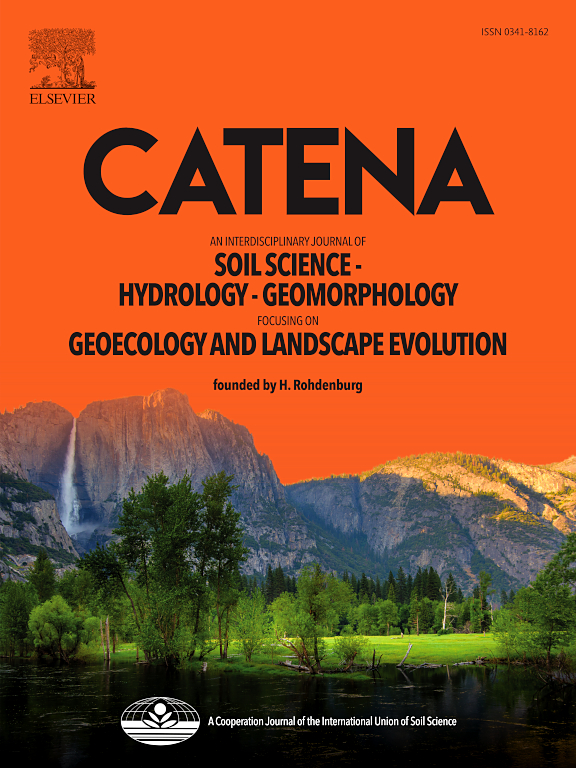Elevation and seasonal variation patterns of soil respiration components and their influencing factors in Pinus taiwanensis forests in Wuyi mountain, China
IF 5.4
1区 农林科学
Q1 GEOSCIENCES, MULTIDISCIPLINARY
引用次数: 0
Abstract
Understanding how elevation gradients influence soil respiration in forest ecosystems is crucial for predicting carbon (C) dynamics under climate change. This study conducted long-term monitoring of Pinus taiwanensis forest soil respiration across elevation gradient and examined the response mechanisms of soil respiration and temperature sensitivity to elevation-driven variations in soil environmental factors in the Wuyi Mountain National Nature Reserve. The results revealed that the monthly dynamics of soil respiration rate closely aligned with soil temperature fluctuations. The Van’t Hoff model effectively captured the relationship among soil respiration with soil temperature, explaining up to 90 % of the observed variation. The relationship between soil moisture and soil respiration was not adequately captured by a univariate equation (R2 = 0.001–0.195). However, soil moisture still accounted for an average of 9.62 % of the variation in soil respiration and temperature sensitivity (Q10). Notably, soil moisture exhibited a significant negative correlation with the Q10 of heterotrophic respiration (QRH) (p < 0.01) and was significantly associated with other soil environmental factors (p < 0.05). Both the annual flux of total soil respiration (ERS) and heterotrophic respiration (ERH) decreased with increasing elevation. The annual flux of autotrophic respiration (ERA) and ERA/ERS initially increased with elevation before declining, while ERH/ERS and ERH/ERA displayed the inverse trend. The Q10 did not exhibit a linear increase with elevation but rather fluctuated within the 1400 m-1600 m. The Q10 showed a significant positive correlation with acid phosphatase (ACP) (p < 0.01), whereas available phosphorus (AP) exhibited an inverse relationship (p < 0.01). Overall, random forest analysis revealed that soil environmental factors explained 89.15 %-95.21 % of the variation in soil respiration and its temperature sensitivity across the elevation gradient, with soil moisture and temperature contributing 9.62 % and 5.65 %, respectively. Additionally, ACP, nitrate nitrogen (NO3-N) and soil organic carbon (SOC) were also identified as key explanatory variables.
中国武夷山台湾松林土壤呼吸成分的海拔和季节变化规律及其影响因素
了解海拔梯度如何影响森林生态系统的土壤呼吸对于预测气候变化下的碳(C)动态至关重要。本研究对武夷山国家级自然保护区台湾松林土壤呼吸进行了跨海拔梯度的长期监测,探讨了土壤呼吸和温度敏感性对海拔驱动土壤环境因子变化的响应机制。结果表明,土壤呼吸速率的月变化与土壤温度的变化密切相关。范霍夫模型有效地捕捉了土壤呼吸与土壤温度之间的关系,解释了高达90%的观察到的变化。单变量方程(R2 = 0.001 ~ 0.195)不能充分反映土壤湿度与土壤呼吸的关系。然而,土壤湿度仍占土壤呼吸和温度敏感性变化的平均9.62% (Q10)。土壤湿度与异养呼吸(QRH) Q10呈显著负相关(p <;0.01),与其他土壤环境因子极显著相关(p <;0.05)。土壤总呼吸(ERS)和异养呼吸(ERH)的年通量均随海拔升高而减小。年自养呼吸通量(ERA)和ERA/ERS随海拔升高呈先升高后下降的趋势,ERH/ERS和ERH/ERA呈相反趋势。Q10不随海拔呈线性增加,而是在1400 ~ 1600 m范围内波动。Q10与酸性磷酸酶(ACP)呈显著正相关(p <;0.01),而速效磷(AP)呈反比关系(p <;0.01)。随机森林分析结果表明,土壤环境因子对土壤呼吸及其温度敏感性的贡献率为89.15% ~ 95.21%,其中土壤湿度和温度对土壤呼吸及其温度敏感性的贡献率分别为9.62%和5.65%。ACP、硝态氮(NO3-N)和土壤有机碳(SOC)也被认为是主要的解释变量。
本文章由计算机程序翻译,如有差异,请以英文原文为准。
求助全文
约1分钟内获得全文
求助全文
来源期刊

Catena
环境科学-地球科学综合
CiteScore
10.50
自引率
9.70%
发文量
816
审稿时长
54 days
期刊介绍:
Catena publishes papers describing original field and laboratory investigations and reviews on geoecology and landscape evolution with emphasis on interdisciplinary aspects of soil science, hydrology and geomorphology. It aims to disseminate new knowledge and foster better understanding of the physical environment, of evolutionary sequences that have resulted in past and current landscapes, and of the natural processes that are likely to determine the fate of our terrestrial environment.
Papers within any one of the above topics are welcome provided they are of sufficiently wide interest and relevance.
 求助内容:
求助内容: 应助结果提醒方式:
应助结果提醒方式:


